Lee Smolin gave a lecture at the Perimeter Institute this week. Here’s the blurb: “On April 17, in a special webcast talk based on his latest book, Einstein’s Unfinished Revolution, Perimeter’s Lee Smolin will argue that the problems that have bedeviled quantum physics since its inception are unsolved and unsolvable for the simple reason that the theory is incomplete. There is more to quantum physics waiting to be discovered”. This sounds interesting. It’s definitely my kind of thing. Let’s take a look.
00:49 Greg Dick starts with an introduction and congratulations about the EHG black hole images. I’m totally happy with black holes, but a little chary about the EHG results. It’s a big collaboration, there’s been a lot of hype, and they’re claiming their observations are compatible with a Kerr black hole. Kerr black holes are said to permit wormholes and time travel. They are not compatible with the”coordinate” speed of light varying in a gravitational field.
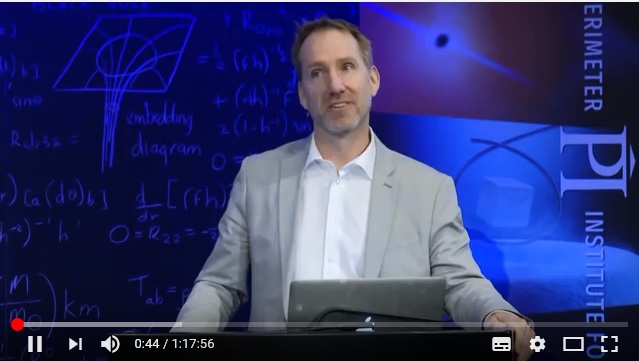
2:41 Greg Dick: introduces Lee Smolin. Smolin’s CV is long, but his actual contributions to physics is hard to pin down. But no matter, because “tonight Lee will share with us his vision for the future of quantum physics”.
4:01 Lee Smolin takes the stage and gives thanks. He says the first lecture featured Roger Penrose. That’s Roger Penrose of Penrose diagram fame – the Penrose diagrams that plot a path to the parallel antiverse. But no matter, tonight Lee is going to talk about the problem with quantum mechanics. That’s good. That’s something I want to hear about.
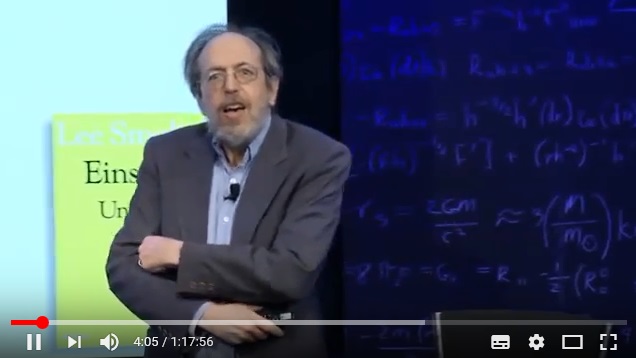
6:00 Smolin says he writes his books to think about the questions the books are about. Fair enough. He say he wanted to write a book about quantum foundations. He says quantum mechanics was the great conundrum for Einstein, who was in on the ground floor with his 1905 paper on the photoelectric effect.
8:12 Smolin says Einstein published a paper about light in which he introduced the very puzzling idea that light is both a wave and a particle. Tsk. Smolin doesn’t know about Pascual Jordan’s 1925 paper. I don’t think he’s read Anthony Duncan and Michel Janssen’s 2007 paper on Pascual Jordan’s resolution of the conundrum of the wave-particle duality of light.
8:42 Smolin say quantum mechanics has foundational problems which indicate it is also incomplete. That’s good. But does he know just how incomplete? I suspect not, because he also says we need to unify gravity, spacetime, and the quantum, to find the quantum theory of gravity. That’s unfortunate, because once you know how gravity works and how electromagnetism works, you know that quantum gravity is a castle in the air.
10:14 Smolin talks about Schrodinger’s cat, but doesn’t say Schrodinger proposed his cat to show how ridiculous the Copenhagen interpretation was. But he talks about making sense of quantum mechanics and it says it doesn’t make any sense because it’s wrong. That’s courageous of him. He said Penrose felt this way, so fair play to Penrose.
11:52 Smolin says he does science because he wants to understand how nature is. Good stuff. This is not shut up and calculate or that’s mere philosophy.
13:20 Smolin talks about being a realist. I’m a realist. He also talks about be-ables and observables and a realist theory and operational theory. OK.
15:09: Smolin says several of the founders of quantum mechanics were not realists. Quite right. That’s the trouble with physics, Lee.
17:12 Smolin talks about Niels Bohr, the older mentor who was definitely not a realist. I am not a fan of Bohr. In his Nobel lecture Bohr said this: “We are therefore obliged to be modest in our demands and content ourselves with concepts which are formal in the sense that they do not provide a visual picture of the sort one is accustomed to require of the explanations with which natural philosophy deals”. It was an ominous portent of things to come.
18:08 Smolin talks about Max Born. But he obviously doesn’t know about Born-Infeld theory in the thirties. He obviously hasn’t read their 1935 paper on the quantization of the new field theory II. That’s where they said this: “the inner angular momentum plays evidently a similar role to the spin in the usual theory of the electron. But it has some great advantages: it is an integral of the motion and has a real physical meaning as a property of the electromagnetic field, whereas the spin is defined as an angular momentum of an extensionless point, a rather mystical assumption”. Smolin moves on to Werner Heisenberg, and mentions the phrase anti-realists. He says the final theory of quantum mechanics in 1927 was not consistent with reality. I’m pleased to hear him saying this.
19:52 Smolin asks if this matters. You bet it does. But what? What’s this dig about people who want to gain power who don’t want to believe in rationality and evidence? I knew Trump was going to get elected when I saw the documentary about Youngstown Ohio. It’s been used as the set for a zombie move. Blue-collar America was betrayed by people like you, Lee. So leave the politics out of this.
20:59 Smolin talks about post-modernism being free from any dependence on the concept of objective truth. He doesn’t like that, and neither do I.
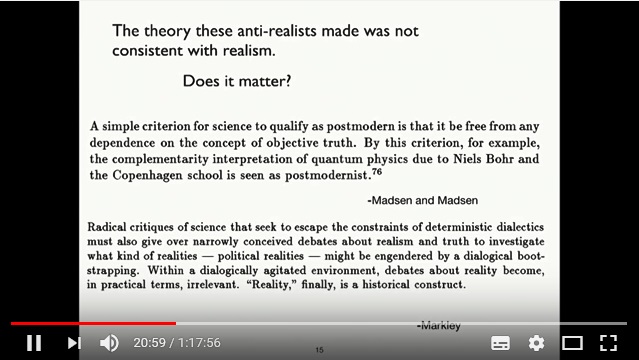
23:25 Smolin says he needs to bring us up to speed on the basic principles of quantum mechanics. He starts with the uncertainty principle, but doesn’t say it’s merely an attribute of wavelike systems. Instead he talks about particles. It’s as if Smolin doesn’t know that particles are waves. He doesn’t know that that’s why the principle is true.
25:41 Smolin talks about things coming in pairs, such as position and momentum, and electric field and magnetic field. He doesn’t understand electromagnetism. He mentions h-bar but he doesn’t know why h applies to all photons. he doesn’t know that the quantum nature of light is hiding in plain sight.
26:19 Smolin talks about the superposition principle. He shows a picture of the double slit experiment showing wave interference. That’s good. He talks about waves on a pond, but he doesn’t follow through by not saying that quantum superposition is proof positive of the wave nature of light and matter.
27:54 Smolin says there’s one law for Newtonian physics, but there’s two laws for quantum mechanics, and that’s the whole problem. You use one law if you measure the system, and another if you don’t. His slide says this Rule1: except during a measurement, the wave evolves smoothly and deterministically, like a wave on water. He doesn’t know about detection being akin to an optical Fourier transform.
30:13 Smolin talks about a wave taking many paths. That’s good. He says “What does that wave mean?” But doesn’t say. Nor does he say the wavefunction is the particle. He hasn’t been talking to Jeff Lundeen in Ottawa.
31:00 Smolin says rule 2 only applies when we make a measurement. It effectively says “look for the particle somewhere” and “I can tell you the probability of finding it there”. He talks about the square of the wave height, but he doesn’t know that when you measure a system, two wavefunctions interact.
33:00 Smolin says he wants to emphasize that quantum mechanics has been extremely successful in generating experimental predictions that are confirmed. I rather thought the predictions were postdictions.
33:20 Smolin says “and yet my message to you today is that it is wrong”. Good man Lee, but you don’t know the half of it. It isn’t just wrong, it’s not even wrong.
34:30 Smolin says let me emphasize the problem. He talks about an antiproton at the LHC and says rule1 and rule 2 contradict one another.
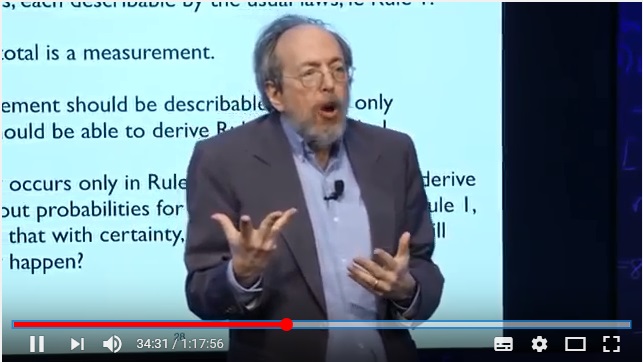
37:50 Smolin talks about deriving rule 2 from rule 1 and refers to the measurement problem. He says he’s been worrying about it since he was 17. What a pity he doesn’t understand it. But it’s good to see him admitting that some people are getting in the way of progress.
39:51 Smolin says he wants to break through and understand quantum mechanics for real. It’s a pity that people like him are only saying things like this almost a hundred years after quantum mechanics was formulated.
40:00 Smolin talks about Schrödinger’s cat. Again without saying Schrödinger proposed his cat to show how ridiculous the Copenhagen Interpretation was. He’s never read Schrödinger’s 1926 paper quantization as a problem of proper values, part II. That’s where Schrödinger talked about light rays influencing one another and showing remarkable curvature.
41:54 Smolin’s slide say QM fails to give us a detailed description of what is going on in individual atomic, molecular, and nuclear processes. It has nothing to say about where the electrons and photons are and how they are moving. It doesn’t give us a description of electrons or photons either, or how we make electrons and positrons out of photons in gamma-gamma pair production. These are the very foundations of quantum mechanics. But Smolin doesn’t appreciate that, and carries on. He’s missed the trick.
43:05 Smolin says we should be finding the deeper theory behind quantum mechanics. Good. Then physics can explain how a magnet works.
43:29 Smolin says the big clue is non-locality and entanglement. It isn’t.
44:17 Smolin is talking on and on about entanglement. He’s missed the bleedin’ obvious. You have to understand the photon before you get sucked into the quantum mysticism called entanglement. Has he not talked to Joy Christian? Joy Christian was at the Perimeter Institute until he got hammered for challenging quantum spookiness.
46:20 Smolin is still talking about entanglement. He’s been sidetracked into the Einstein-Podolsky-Rosen “paradox” paper of 1935, and the clock is ticking. Smolin talks about particle A with momentum p and particle B with momentum -p. Then he talks about measuring the position of particle A, and says particle B will have the opposite position. Even though we don’t know where it is. No Lee.
50:34 Smolin is still bogged down on entanglement. He says there’s a flaw in the argument in that you have to be local to interact with your particles. Then he moves on to John Bell. I have heard all this before. I wager Joy Christian will have something to say about all this. Joy Christan said Bell didn’t consider rotations, which do not commute. See the 2007 New Scientist article written by Mark Buchanan called Quantum Entanglement: Is Spookiness Under Threat?
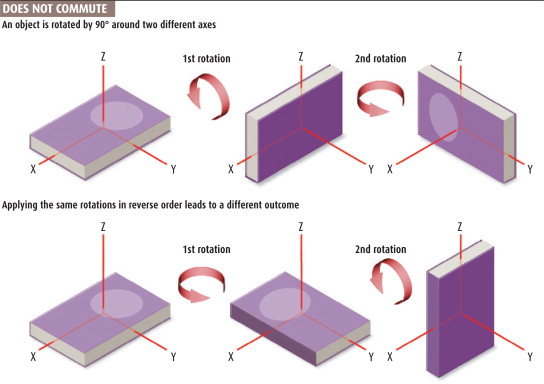 Rotations image from New Scientist
Rotations image from New Scientist
54:24 Smolin is still talking about entanglement, and the Bell inequality. He talks about an atomic decay which produces two photons, and measurements of photon polarization allegedly proves that quantum mechanics is spooky. It isn’t.
56:33 Smolin says Alain Aspect and collaborators in Paris found that Bell’s Inequality was massively violated. Hence you can affect the value of property X of particle B by what you choose to measure on particle A. Smolin says let that sink in. What a pity he got that one wrong. He says he’s a realist, but he’s bought the quantum mysticism hook line and sinker.
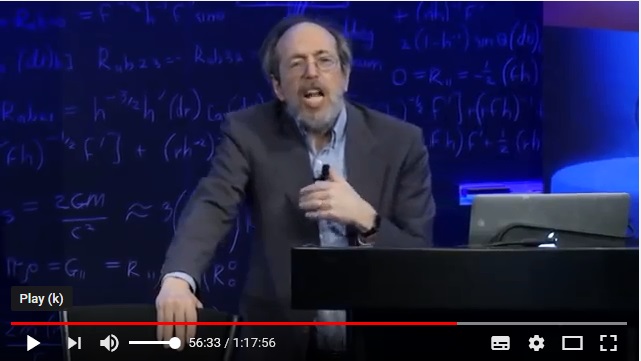
57:45 Smolin says quantum mechanics covers up the how of this by giving only statistics. In a nutshell, he says this: “If you want a realist theory you have to understand how your measurement of particle A affects particle B”. In a nutshell I say this: “What a pity it doesn’t”.
58:56 Smolin says he’s going to stop there and ask for questions. My question would be why did you bypass the fundamental physics? the other questions were:
1:00:16 Do you think humans can understand the universe? Lee Smolin says “I don’t know but I’m going to try”. Not enough Lee. Not enough.
1:01:42 What do you make of the idea of the multiverse? Smolin says his book devotes two chapters to the many-worlds interpretation of quantum mechanics. FFS. He should be dismissing that in two sentences. Somebody please explain the double-slit experiment to him. But at least at 1:03:04 Smolin says he thinks it’s crazy. Hooray.
1:04:23 Would it be possible that light would have a constant speed because it’s interacting with a quantum force like the strong force? What a pity Smolin doesn’t know that the speed of light varies in the room you’re in. Nor does he know that the elastic quality of the bag model is related to the elastic quality of space which makes light wave propagate. A kid asked this question. Somebody tell him about the physics detective.
1:06:06 Given that locality is dead and I can affect a particle over here that affects a particle over there, does that imply some speed of light violation? Smolin was unsure of himself, and rather waffly. He said the special relativity speed limit applies to collider physics, but maybe it’s possible we could see information travelling faster than light.

1:08:36 I’m trying to wrap my head round this idea that quantum mechanics is “wrong” and how you can state that definitively. Because we’ve clearly experimented with the theory of quantum mechanics and established correct results. Just because there are elements we can’t explain doesn’t mean the theory is wrong. So I don’t know how you can call it wrong just because there’s a lack of information. Smolin said he could, with Einstein and other people, retreat back to “incomplete”. But he said “let me give you a historical fable. A complete version of quantum mechanics was presented by Louis de Broglie at a famous conference in Brussels. His theory was rejected. Supposing there had been a different history where all the young physicists went to Paris instead of Copenhagen. Because of that we could have had the Standard Model in 1940 and quantum gravity in 1965”. Smolin is on the right track with that. But again he doesn’t know the half of it – if he did he wouldn’t be talking about the Standard Model and quantum gravity.
1:14:08 Often advancements in thought are often made when deep-rooted assumptions are challenged. Like locality. Do you think our problem with quantum mechanics is that we are basing it on some incorrect assumption? If so any guesses on what that might be? Smolin talked about black and white things in comedies, but said the real situation is more complicated. He referred to Feynman, who repeatedly said nobody understands quantum mechanics. He also said Feynman didn’t tackle this issue, and instead worked on things he could make progress on. Smolin said he did too, and made the wrong decision.
The real issue is of course, is whether Smolin, and people like him, will make the right decisions in future. He’s moving in the right direction with all this, but there is just so much that he doesn’t know. The problem is, that he doesn’t know it.
The author seems to know the answers… where can I read the explanations that the author gives to these problems?
Francisco: see the articles listed here:
.
https://physicsdetective.com/articles/articles-on-gravity-and-cosmology/
.
You need to start off knowing that a gravitational field is a place where the speed of light is “spatially variable”, and that this is why light curves downwards. Then apply the wave nature of matter and electron spin, and think of the electron as light a closed path, like de Broglie and Schrodinger said. Then you can understand why matter falls down. After that you can appreciate that a black hole is a place where the “coordinate” speed of light is zero, and that infalling matter is falling faster and faster but cannot fall faster than the local speed of light. One thing leads to another, and I think it’s all fairly simple really.